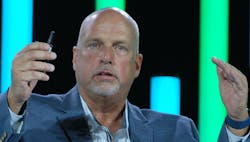Personify customers to meet their needs
At the start of his Perspectives presentation during the opening of Automation Fair, Rockwell Automation’s signature event, Senior Vice President Software and Control Brian Shepherd introduced us to Henri. Henri is the head of manufacturing for a large company, responsible for making big decisions, allocating resources, supervising a large workforce, etc. “He can say yes when others say no,” explained Shepherd, who added that Henri is not real, really, but rather a persona his team uses to help them develop new offerings for customers with a value-driven mindset.
“We at Rockwell take a system-engineering approach to deliver remarkable new innovations that come together in the form of industry solutions tailored exactly for the needs of our customers,” said Shepherd during his introduction. “If it matters to the customers,” he explained, “it matters to us.”
And that gets us back to our fictional friend Henri.
The way the Rockwell team imagines it, Henri is responsible for dealing with new technology coming into his manufacturing environment, alongside his CIO and chief information security officer. Henri knows—just like the presenter Shepherd does—that decisions around manufacturing technology no longer affect just the manufacturing organization within a larger enterprise; they affect the whole enterprise. These are enterprise decisions.
The significance of those decisions informs what Shepherd then detailed as four key value drivers his team considers when developing new programs.
Production: Henri wakes up every day with the challenge to meet production needs, bring new products to market as fast as possible, implement new processes for new assets, and launch new training programs for his teams. He must always consider maximum efficiency by reducing inputs and costs. He must also prioritize maximizing output—putting the pedal to the metal to deliver as much as possible.
Assets: Manufacturing is a huge consumer of assets in any company, Shepherd noted. Henri and team are compelled to squeeze every bit of productivity out of their assets, relying on new technology to monitor those assets, to capture availability and performance, and use these tools to predict when machines will need maintenance. Henri wants to use new technology like augmented reality to share the knowledge of the most experienced workers with teams around the world.
Compliance & sustainability: Henri’s team is subject to an avalanche of requirements for safety, security, quality, etc. He needs process controls, record keeping, and comprehensive reporting to address those requirements. His company is also making public sustainability commitments, which puts demands on his manufacturing organization to use less while being more efficient with water, and to participate in the circular economy allowing products to live on and live again.
Transformation: Henri has been hearing for years about the potential for new technology to transform manufacturing…a dream that sometimes seems far away from reality. His team are experts at manufacturing, not transformation. So, who does he trust? Who does he listen to? Where does he start? He needs a trusted guide. A partner with the experience and technology to help with these key value drivers.
He turns, according to Shepherd’s scenario, to Rockwell Automation and its buyer-focused strategy.
“One of our principles to be system focused,” the SVP explained. It’s not about focusing on a single product, rather adopting the customer’s viewpoint.
Shepherd used the example of giving Henri a whiteboard marker and asking him to sketch out his production system in the modern era. The results, in this scenario, would resemble Rockwell Automation’s Connected Enterprise Production System, which represents the technologies and capabilities required all the way along the manufacturing lifecycle and at every level of the technology stack, per Shepherd.
The Connected Enterprise Production System, including software solutions from on-premise to cloud and the integration of recent technology acquisitions, empowers smart manufacturing that is the gateway to digital transformation. Smart devices within Rockwell Automation’s system open new windows of visibility into processes. Data and analytics enable better and faster decision-making. Seamless connectivity spurs new collaboration, converging plant-level and enterprise networks, and securely connecting people, processes, and technologies.
“We believe in the power of data,” explained Shepherd. “And we at Rockwell have the technology and expertise to achieve results and transform manufacturing.” Central to that mission is the Connected Enterprise Production System, which Shepherd described as a new way to approach systems engineering. And it has Henri’s endorsement.
The editors of Control, Control Design and Smart Industry are reporting live from Automation Fair. When the event comes to a close, the editors will compile a report of the best, most important coverage from the event. Register now to pre-order the report and be among the first to receive it in your inbox. Pre-order your copy now.
About the Author
Chris McNamara
Smart Industry

Leaders relevant to this article:
